Comprehensive Report: Tesco's Learning and Development Strategy
VerifiedAdded on 2022/12/29
|18
|4570
|92
Report
AI Summary
This report presents an analysis of a Learning and Development (L&D) Strategy, focusing on its key components and implementation. The strategy outlines the importance of aligning L&D with the HR strategy and involves consultation with stakeholders and senior management approval. It emphasizes the role of a personnel officer for implementation and regular progress reporting. The report provides a detailed overview of the current environment, including external and internal factors like government policies, economic conditions, and internal organizational capacity. The purpose of the strategy is to design training and development programs in areas like customer service, teamwork, and equipment operation. The report highlights the target audience, including HR units and line managers, and discusses various learning approaches, such as on-the-job learning, group learning, and tutor-led interventions. It also covers the identification of L&D needs through Training Needs Analysis (TNA) and Performance Management and Development System (PMDS), followed by the development of training plans. Finally, the report addresses how learning and development needs will be addressed through various strategies like group discussions, on-the-job learning, and networking. The report underscores the assignment of responsibility for driving and implementing the strategy.
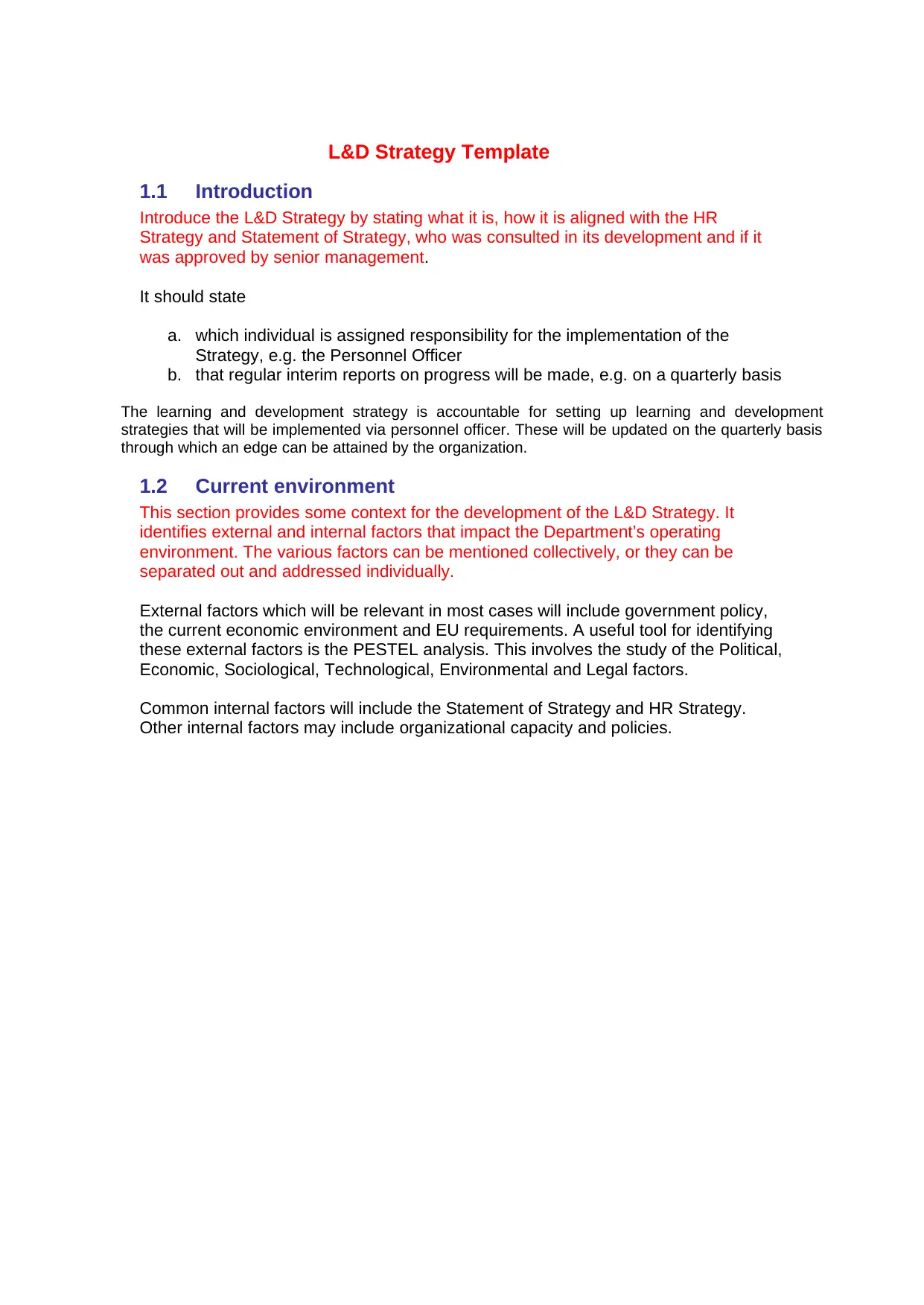
L&D Strategy Template
1.1 Introduction
Introduce the L&D Strategy by stating what it is, how it is aligned with the HR
Strategy and Statement of Strategy, who was consulted in its development and if it
was approved by senior management.
It should state
a. which individual is assigned responsibility for the implementation of the
Strategy, e.g. the Personnel Officer
b. that regular interim reports on progress will be made, e.g. on a quarterly basis
The learning and development strategy is accountable for setting up learning and development
strategies that will be implemented via personnel officer. These will be updated on the quarterly basis
through which an edge can be attained by the organization.
1.2 Current environment
This section provides some context for the development of the L&D Strategy. It
identifies external and internal factors that impact the Department’s operating
environment. The various factors can be mentioned collectively, or they can be
separated out and addressed individually.
External factors which will be relevant in most cases will include government policy,
the current economic environment and EU requirements. A useful tool for identifying
these external factors is the PESTEL analysis. This involves the study of the Political,
Economic, Sociological, Technological, Environmental and Legal factors.
Common internal factors will include the Statement of Strategy and HR Strategy.
Other internal factors may include organizational capacity and policies.
1.1 Introduction
Introduce the L&D Strategy by stating what it is, how it is aligned with the HR
Strategy and Statement of Strategy, who was consulted in its development and if it
was approved by senior management.
It should state
a. which individual is assigned responsibility for the implementation of the
Strategy, e.g. the Personnel Officer
b. that regular interim reports on progress will be made, e.g. on a quarterly basis
The learning and development strategy is accountable for setting up learning and development
strategies that will be implemented via personnel officer. These will be updated on the quarterly basis
through which an edge can be attained by the organization.
1.2 Current environment
This section provides some context for the development of the L&D Strategy. It
identifies external and internal factors that impact the Department’s operating
environment. The various factors can be mentioned collectively, or they can be
separated out and addressed individually.
External factors which will be relevant in most cases will include government policy,
the current economic environment and EU requirements. A useful tool for identifying
these external factors is the PESTEL analysis. This involves the study of the Political,
Economic, Sociological, Technological, Environmental and Legal factors.
Common internal factors will include the Statement of Strategy and HR Strategy.
Other internal factors may include organizational capacity and policies.
Paraphrase This Document
Need a fresh take? Get an instant paraphrase of this document with our AI Paraphraser
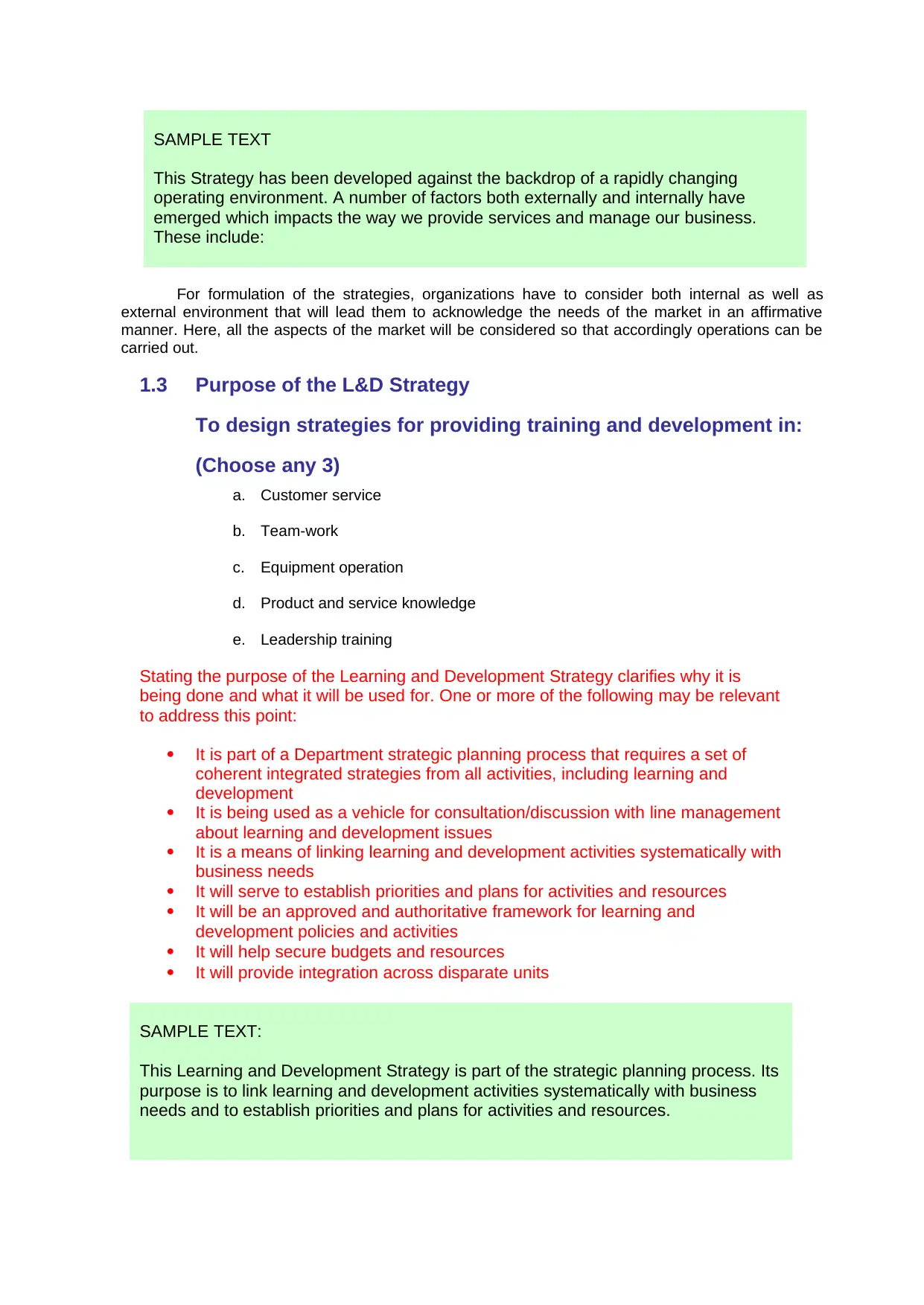
SAMPLE TEXT:
This Learning and Development Strategy is part of the strategic planning process. Its
purpose is to link learning and development activities systematically with business
needs and to establish priorities and plans for activities and resources.
SAMPLE TEXT
This Strategy has been developed against the backdrop of a rapidly changing
operating environment. A number of factors both externally and internally have
emerged which impacts the way we provide services and manage our business.
These include:
For formulation of the strategies, organizations have to consider both internal as well as
external environment that will lead them to acknowledge the needs of the market in an affirmative
manner. Here, all the aspects of the market will be considered so that accordingly operations can be
carried out.
1.3 Purpose of the L&D Strategy
To design strategies for providing training and development in:
(Choose any 3)
a. Customer service
b. Team-work
c. Equipment operation
d. Product and service knowledge
e. Leadership training
Stating the purpose of the Learning and Development Strategy clarifies why it is
being done and what it will be used for. One or more of the following may be relevant
to address this point:
It is part of a Department strategic planning process that requires a set of
coherent integrated strategies from all activities, including learning and
development
It is being used as a vehicle for consultation/discussion with line management
about learning and development issues
It is a means of linking learning and development activities systematically with
business needs
It will serve to establish priorities and plans for activities and resources
It will be an approved and authoritative framework for learning and
development policies and activities
It will help secure budgets and resources
It will provide integration across disparate units
This Learning and Development Strategy is part of the strategic planning process. Its
purpose is to link learning and development activities systematically with business
needs and to establish priorities and plans for activities and resources.
SAMPLE TEXT
This Strategy has been developed against the backdrop of a rapidly changing
operating environment. A number of factors both externally and internally have
emerged which impacts the way we provide services and manage our business.
These include:
For formulation of the strategies, organizations have to consider both internal as well as
external environment that will lead them to acknowledge the needs of the market in an affirmative
manner. Here, all the aspects of the market will be considered so that accordingly operations can be
carried out.
1.3 Purpose of the L&D Strategy
To design strategies for providing training and development in:
(Choose any 3)
a. Customer service
b. Team-work
c. Equipment operation
d. Product and service knowledge
e. Leadership training
Stating the purpose of the Learning and Development Strategy clarifies why it is
being done and what it will be used for. One or more of the following may be relevant
to address this point:
It is part of a Department strategic planning process that requires a set of
coherent integrated strategies from all activities, including learning and
development
It is being used as a vehicle for consultation/discussion with line management
about learning and development issues
It is a means of linking learning and development activities systematically with
business needs
It will serve to establish priorities and plans for activities and resources
It will be an approved and authoritative framework for learning and
development policies and activities
It will help secure budgets and resources
It will provide integration across disparate units
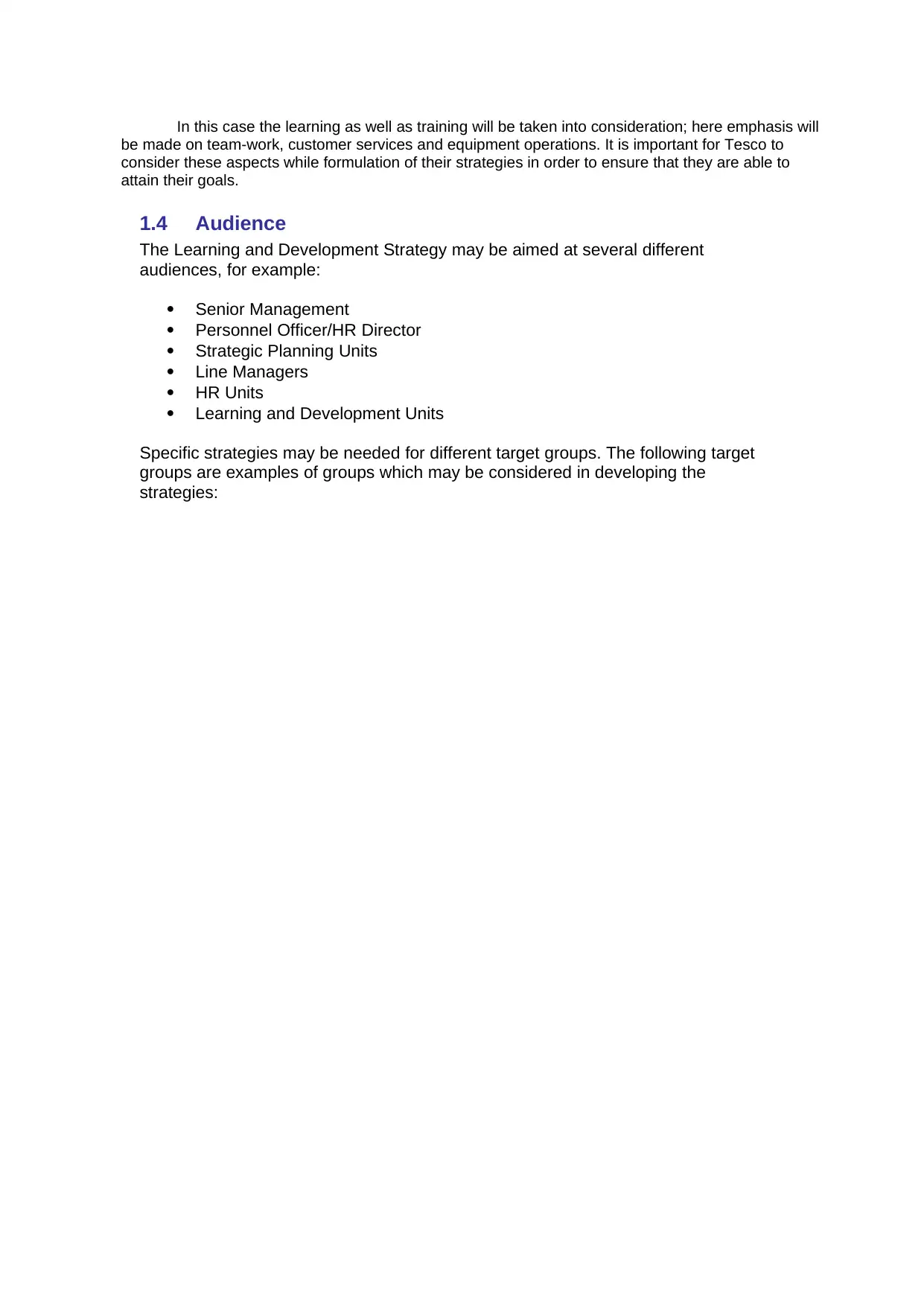
In this case the learning as well as training will be taken into consideration; here emphasis will
be made on team-work, customer services and equipment operations. It is important for Tesco to
consider these aspects while formulation of their strategies in order to ensure that they are able to
attain their goals.
1.4 Audience
The Learning and Development Strategy may be aimed at several different
audiences, for example:
Senior Management
Personnel Officer/HR Director
Strategic Planning Units
Line Managers
HR Units
Learning and Development Units
Specific strategies may be needed for different target groups. The following target
groups are examples of groups which may be considered in developing the
strategies:
be made on team-work, customer services and equipment operations. It is important for Tesco to
consider these aspects while formulation of their strategies in order to ensure that they are able to
attain their goals.
1.4 Audience
The Learning and Development Strategy may be aimed at several different
audiences, for example:
Senior Management
Personnel Officer/HR Director
Strategic Planning Units
Line Managers
HR Units
Learning and Development Units
Specific strategies may be needed for different target groups. The following target
groups are examples of groups which may be considered in developing the
strategies:
⊘ This is a preview!⊘
Do you want full access?
Subscribe today to unlock all pages.

Trusted by 1+ million students worldwide
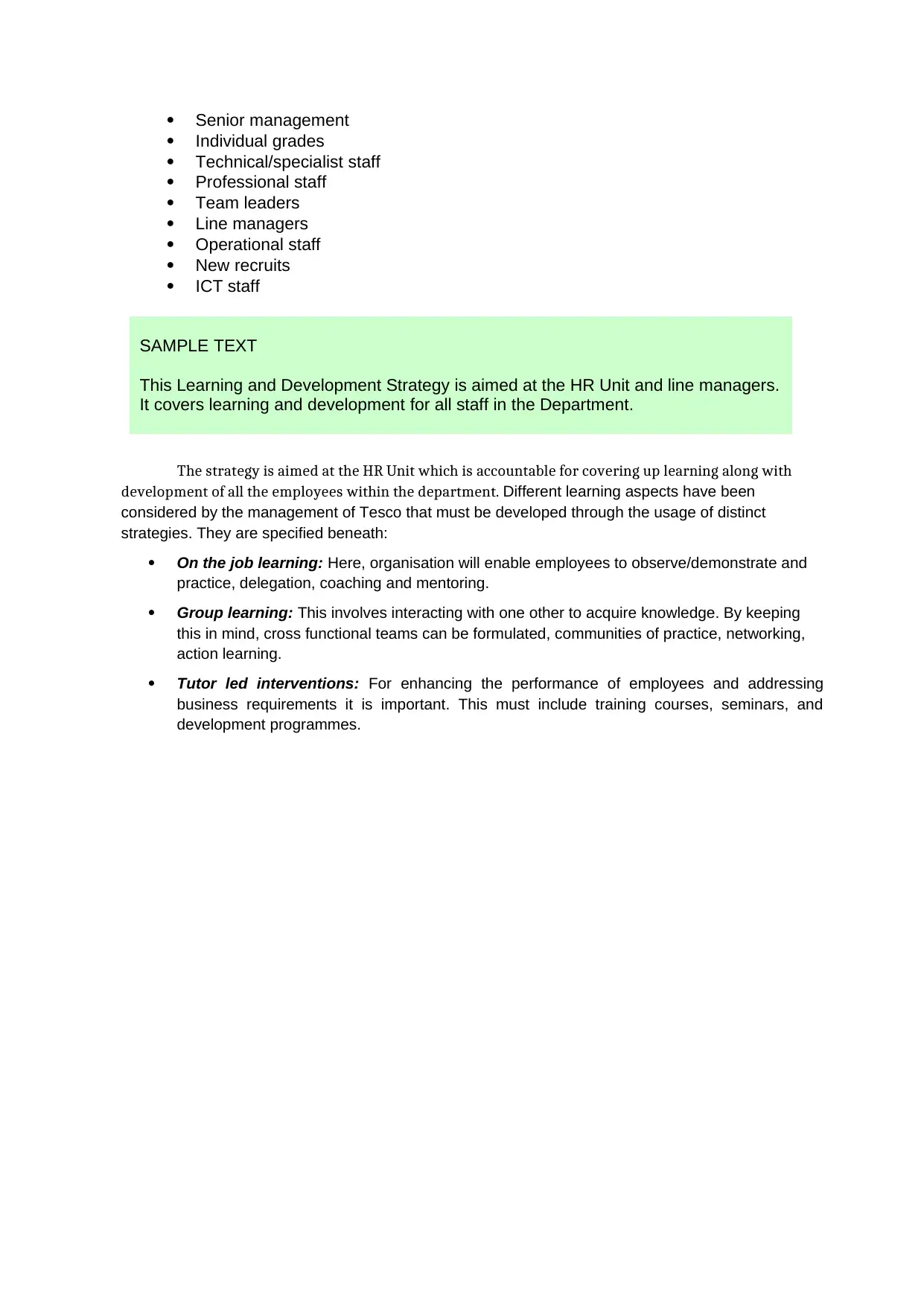
SAMPLE TEXT
This Learning and Development Strategy is aimed at the HR Unit and line managers.
It covers learning and development for all staff in the Department.
Senior management
Individual grades
Technical/specialist staff
Professional staff
Team leaders
Line managers
Operational staff
New recruits
ICT staff
The strategy is aimed at the HR Unit which is accountable for covering up learning along with
development of all the employees within the department. Different learning aspects have been
considered by the management of Tesco that must be developed through the usage of distinct
strategies. They are specified beneath:
On the job learning: Here, organisation will enable employees to observe/demonstrate and
practice, delegation, coaching and mentoring.
Group learning: This involves interacting with one other to acquire knowledge. By keeping
this in mind, cross functional teams can be formulated, communities of practice, networking,
action learning.
Tutor led interventions: For enhancing the performance of employees and addressing
business requirements it is important. This must include training courses, seminars, and
development programmes.
This Learning and Development Strategy is aimed at the HR Unit and line managers.
It covers learning and development for all staff in the Department.
Senior management
Individual grades
Technical/specialist staff
Professional staff
Team leaders
Line managers
Operational staff
New recruits
ICT staff
The strategy is aimed at the HR Unit which is accountable for covering up learning along with
development of all the employees within the department. Different learning aspects have been
considered by the management of Tesco that must be developed through the usage of distinct
strategies. They are specified beneath:
On the job learning: Here, organisation will enable employees to observe/demonstrate and
practice, delegation, coaching and mentoring.
Group learning: This involves interacting with one other to acquire knowledge. By keeping
this in mind, cross functional teams can be formulated, communities of practice, networking,
action learning.
Tutor led interventions: For enhancing the performance of employees and addressing
business requirements it is important. This must include training courses, seminars, and
development programmes.
Paraphrase This Document
Need a fresh take? Get an instant paraphrase of this document with our AI Paraphraser
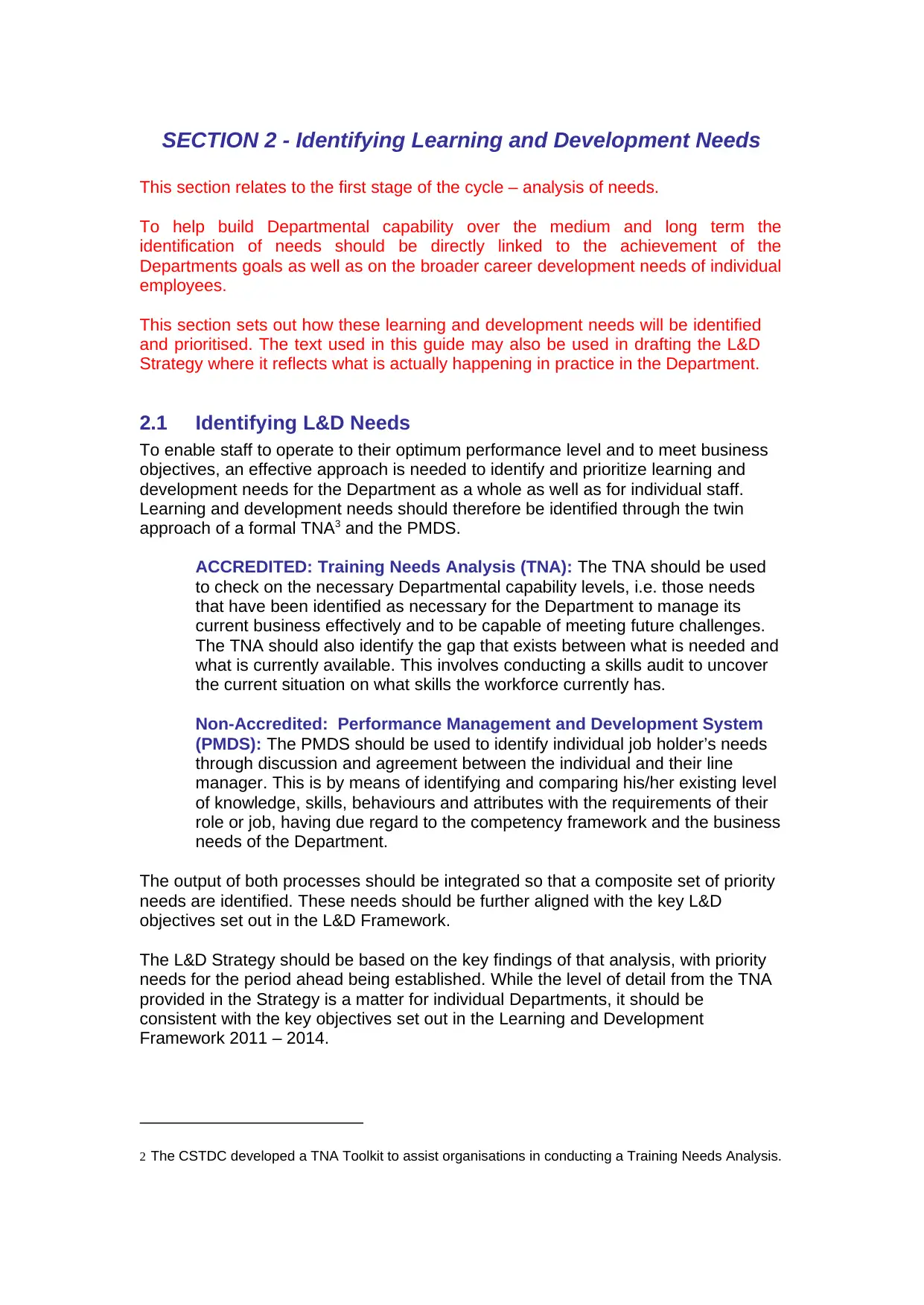
SECTION 2 - Identifying Learning and Development Needs
This section relates to the first stage of the cycle – analysis of needs.
To help build Departmental capability over the medium and long term the
identification of needs should be directly linked to the achievement of the
Departments goals as well as on the broader career development needs of individual
employees.
This section sets out how these learning and development needs will be identified
and prioritised. The text used in this guide may also be used in drafting the L&D
Strategy where it reflects what is actually happening in practice in the Department.
2.1 Identifying L&D Needs
To enable staff to operate to their optimum performance level and to meet business
objectives, an effective approach is needed to identify and prioritize learning and
development needs for the Department as a whole as well as for individual staff.
Learning and development needs should therefore be identified through the twin
approach of a formal TNA3 and the PMDS.
ACCREDITED: Training Needs Analysis (TNA): The TNA should be used
to check on the necessary Departmental capability levels, i.e. those needs
that have been identified as necessary for the Department to manage its
current business effectively and to be capable of meeting future challenges.
The TNA should also identify the gap that exists between what is needed and
what is currently available. This involves conducting a skills audit to uncover
the current situation on what skills the workforce currently has.
Non-Accredited: Performance Management and Development System
(PMDS): The PMDS should be used to identify individual job holder’s needs
through discussion and agreement between the individual and their line
manager. This is by means of identifying and comparing his/her existing level
of knowledge, skills, behaviours and attributes with the requirements of their
role or job, having due regard to the competency framework and the business
needs of the Department.
The output of both processes should be integrated so that a composite set of priority
needs are identified. These needs should be further aligned with the key L&D
objectives set out in the L&D Framework.
The L&D Strategy should be based on the key findings of that analysis, with priority
needs for the period ahead being established. While the level of detail from the TNA
provided in the Strategy is a matter for individual Departments, it should be
consistent with the key objectives set out in the Learning and Development
Framework 2011 – 2014.
2 The CSTDC developed a TNA Toolkit to assist organisations in conducting a Training Needs Analysis.
This section relates to the first stage of the cycle – analysis of needs.
To help build Departmental capability over the medium and long term the
identification of needs should be directly linked to the achievement of the
Departments goals as well as on the broader career development needs of individual
employees.
This section sets out how these learning and development needs will be identified
and prioritised. The text used in this guide may also be used in drafting the L&D
Strategy where it reflects what is actually happening in practice in the Department.
2.1 Identifying L&D Needs
To enable staff to operate to their optimum performance level and to meet business
objectives, an effective approach is needed to identify and prioritize learning and
development needs for the Department as a whole as well as for individual staff.
Learning and development needs should therefore be identified through the twin
approach of a formal TNA3 and the PMDS.
ACCREDITED: Training Needs Analysis (TNA): The TNA should be used
to check on the necessary Departmental capability levels, i.e. those needs
that have been identified as necessary for the Department to manage its
current business effectively and to be capable of meeting future challenges.
The TNA should also identify the gap that exists between what is needed and
what is currently available. This involves conducting a skills audit to uncover
the current situation on what skills the workforce currently has.
Non-Accredited: Performance Management and Development System
(PMDS): The PMDS should be used to identify individual job holder’s needs
through discussion and agreement between the individual and their line
manager. This is by means of identifying and comparing his/her existing level
of knowledge, skills, behaviours and attributes with the requirements of their
role or job, having due regard to the competency framework and the business
needs of the Department.
The output of both processes should be integrated so that a composite set of priority
needs are identified. These needs should be further aligned with the key L&D
objectives set out in the L&D Framework.
The L&D Strategy should be based on the key findings of that analysis, with priority
needs for the period ahead being established. While the level of detail from the TNA
provided in the Strategy is a matter for individual Departments, it should be
consistent with the key objectives set out in the Learning and Development
Framework 2011 – 2014.
2 The CSTDC developed a TNA Toolkit to assist organisations in conducting a Training Needs Analysis.
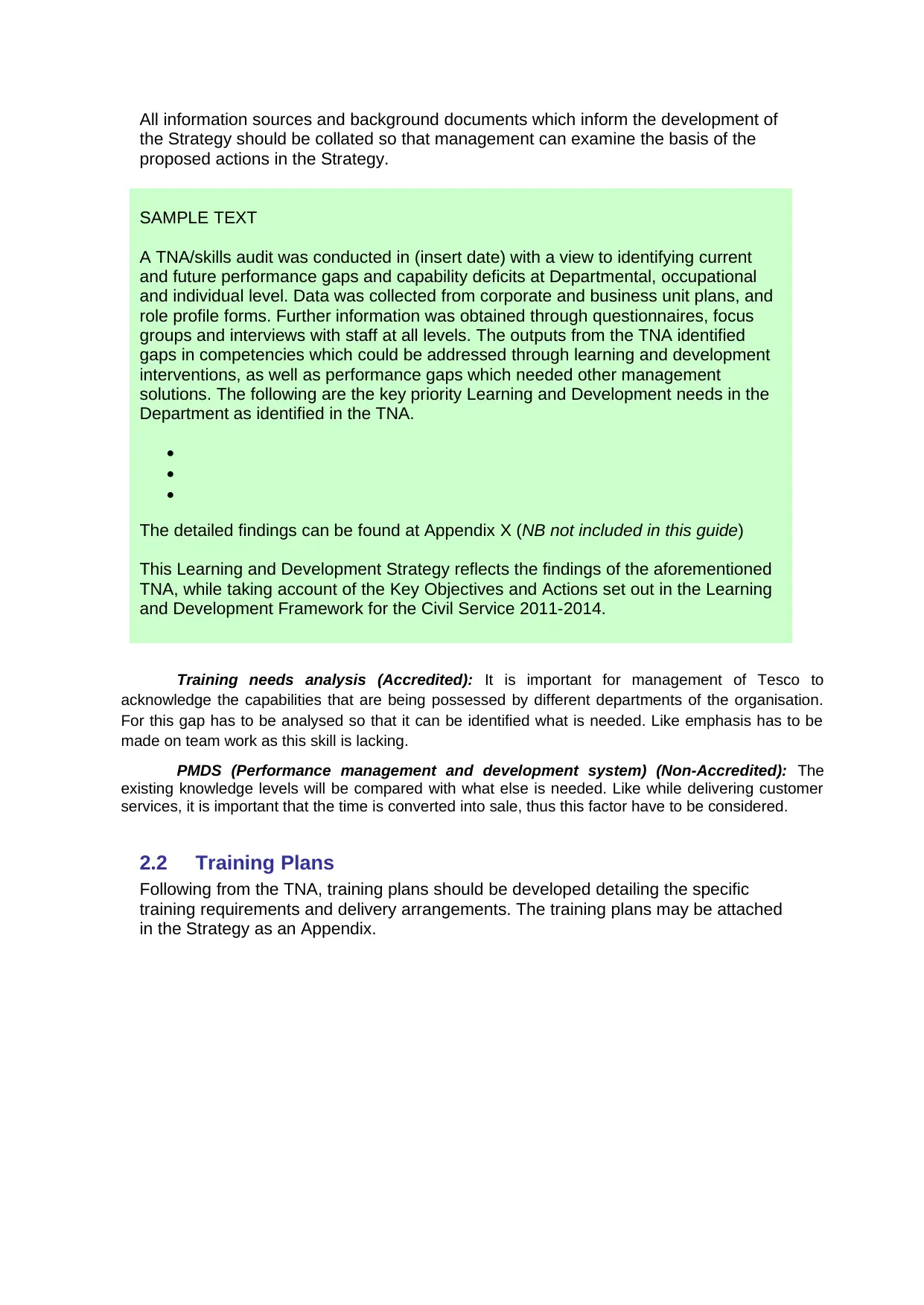
SAMPLE TEXT
A TNA/skills audit was conducted in (insert date) with a view to identifying current
and future performance gaps and capability deficits at Departmental, occupational
and individual level. Data was collected from corporate and business unit plans, and
role profile forms. Further information was obtained through questionnaires, focus
groups and interviews with staff at all levels. The outputs from the TNA identified
gaps in competencies which could be addressed through learning and development
interventions, as well as performance gaps which needed other management
solutions. The following are the key priority Learning and Development needs in the
Department as identified in the TNA.
The detailed findings can be found at Appendix X (NB not included in this guide)
This Learning and Development Strategy reflects the findings of the aforementioned
TNA, while taking account of the Key Objectives and Actions set out in the Learning
and Development Framework for the Civil Service 2011-2014.
All information sources and background documents which inform the development of
the Strategy should be collated so that management can examine the basis of the
proposed actions in the Strategy.
Training needs analysis (Accredited): It is important for management of Tesco to
acknowledge the capabilities that are being possessed by different departments of the organisation.
For this gap has to be analysed so that it can be identified what is needed. Like emphasis has to be
made on team work as this skill is lacking.
PMDS (Performance management and development system) (Non-Accredited): The
existing knowledge levels will be compared with what else is needed. Like while delivering customer
services, it is important that the time is converted into sale, thus this factor have to be considered.
2.2 Training Plans
Following from the TNA, training plans should be developed detailing the specific
training requirements and delivery arrangements. The training plans may be attached
in the Strategy as an Appendix.
A TNA/skills audit was conducted in (insert date) with a view to identifying current
and future performance gaps and capability deficits at Departmental, occupational
and individual level. Data was collected from corporate and business unit plans, and
role profile forms. Further information was obtained through questionnaires, focus
groups and interviews with staff at all levels. The outputs from the TNA identified
gaps in competencies which could be addressed through learning and development
interventions, as well as performance gaps which needed other management
solutions. The following are the key priority Learning and Development needs in the
Department as identified in the TNA.
The detailed findings can be found at Appendix X (NB not included in this guide)
This Learning and Development Strategy reflects the findings of the aforementioned
TNA, while taking account of the Key Objectives and Actions set out in the Learning
and Development Framework for the Civil Service 2011-2014.
All information sources and background documents which inform the development of
the Strategy should be collated so that management can examine the basis of the
proposed actions in the Strategy.
Training needs analysis (Accredited): It is important for management of Tesco to
acknowledge the capabilities that are being possessed by different departments of the organisation.
For this gap has to be analysed so that it can be identified what is needed. Like emphasis has to be
made on team work as this skill is lacking.
PMDS (Performance management and development system) (Non-Accredited): The
existing knowledge levels will be compared with what else is needed. Like while delivering customer
services, it is important that the time is converted into sale, thus this factor have to be considered.
2.2 Training Plans
Following from the TNA, training plans should be developed detailing the specific
training requirements and delivery arrangements. The training plans may be attached
in the Strategy as an Appendix.
⊘ This is a preview!⊘
Do you want full access?
Subscribe today to unlock all pages.

Trusted by 1+ million students worldwide
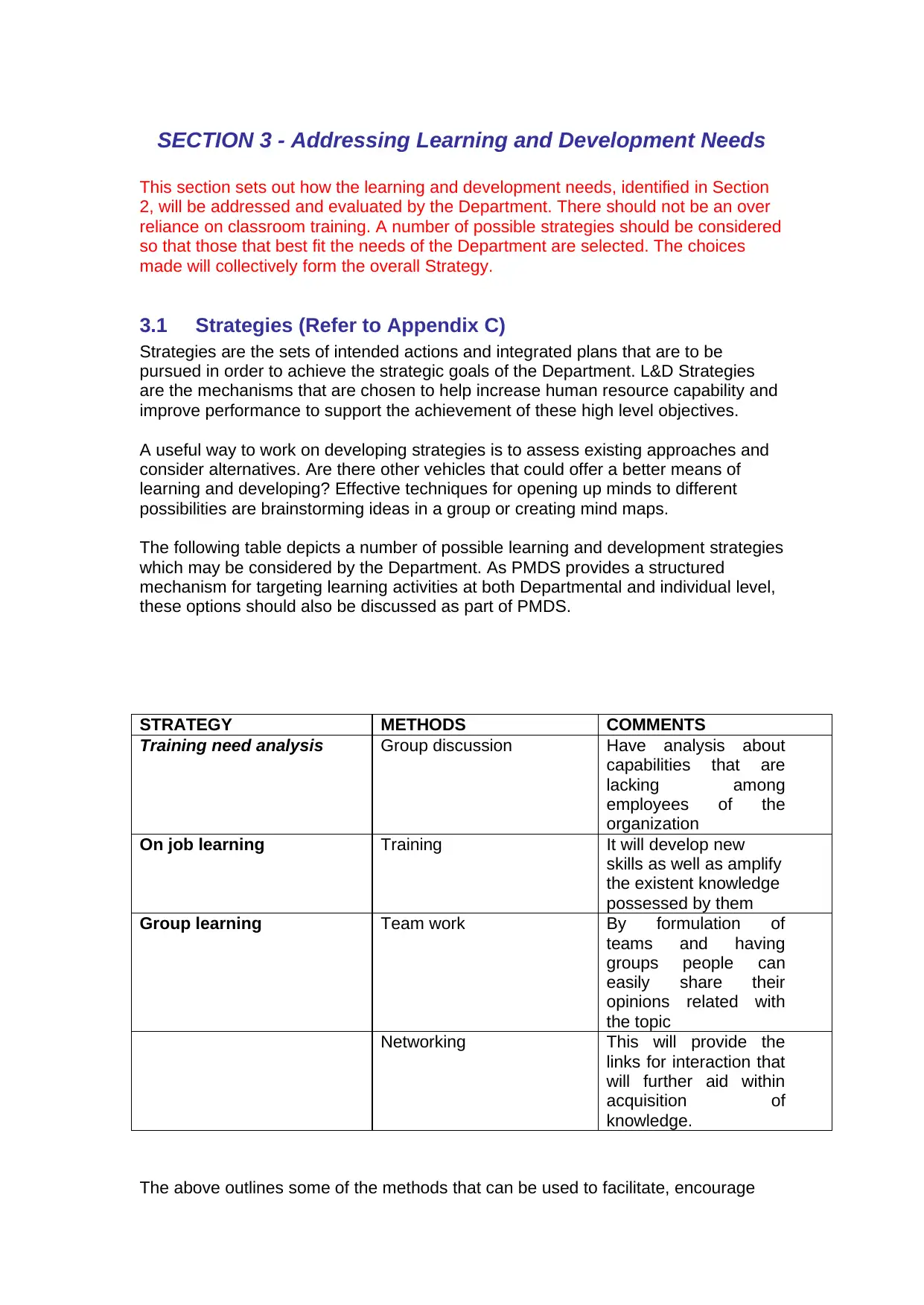
SECTION 3 - Addressing Learning and Development Needs
This section sets out how the learning and development needs, identified in Section
2, will be addressed and evaluated by the Department. There should not be an over
reliance on classroom training. A number of possible strategies should be considered
so that those that best fit the needs of the Department are selected. The choices
made will collectively form the overall Strategy.
3.1 Strategies (Refer to Appendix C)
Strategies are the sets of intended actions and integrated plans that are to be
pursued in order to achieve the strategic goals of the Department. L&D Strategies
are the mechanisms that are chosen to help increase human resource capability and
improve performance to support the achievement of these high level objectives.
A useful way to work on developing strategies is to assess existing approaches and
consider alternatives. Are there other vehicles that could offer a better means of
learning and developing? Effective techniques for opening up minds to different
possibilities are brainstorming ideas in a group or creating mind maps.
The following table depicts a number of possible learning and development strategies
which may be considered by the Department. As PMDS provides a structured
mechanism for targeting learning activities at both Departmental and individual level,
these options should also be discussed as part of PMDS.
STRATEGY METHODS COMMENTS
Training need analysis Group discussion Have analysis about
capabilities that are
lacking among
employees of the
organization
On job learning Training It will develop new
skills as well as amplify
the existent knowledge
possessed by them
Group learning Team work By formulation of
teams and having
groups people can
easily share their
opinions related with
the topic
Networking This will provide the
links for interaction that
will further aid within
acquisition of
knowledge.
The above outlines some of the methods that can be used to facilitate, encourage
This section sets out how the learning and development needs, identified in Section
2, will be addressed and evaluated by the Department. There should not be an over
reliance on classroom training. A number of possible strategies should be considered
so that those that best fit the needs of the Department are selected. The choices
made will collectively form the overall Strategy.
3.1 Strategies (Refer to Appendix C)
Strategies are the sets of intended actions and integrated plans that are to be
pursued in order to achieve the strategic goals of the Department. L&D Strategies
are the mechanisms that are chosen to help increase human resource capability and
improve performance to support the achievement of these high level objectives.
A useful way to work on developing strategies is to assess existing approaches and
consider alternatives. Are there other vehicles that could offer a better means of
learning and developing? Effective techniques for opening up minds to different
possibilities are brainstorming ideas in a group or creating mind maps.
The following table depicts a number of possible learning and development strategies
which may be considered by the Department. As PMDS provides a structured
mechanism for targeting learning activities at both Departmental and individual level,
these options should also be discussed as part of PMDS.
STRATEGY METHODS COMMENTS
Training need analysis Group discussion Have analysis about
capabilities that are
lacking among
employees of the
organization
On job learning Training It will develop new
skills as well as amplify
the existent knowledge
possessed by them
Group learning Team work By formulation of
teams and having
groups people can
easily share their
opinions related with
the topic
Networking This will provide the
links for interaction that
will further aid within
acquisition of
knowledge.
The above outlines some of the methods that can be used to facilitate, encourage
Paraphrase This Document
Need a fresh take? Get an instant paraphrase of this document with our AI Paraphraser
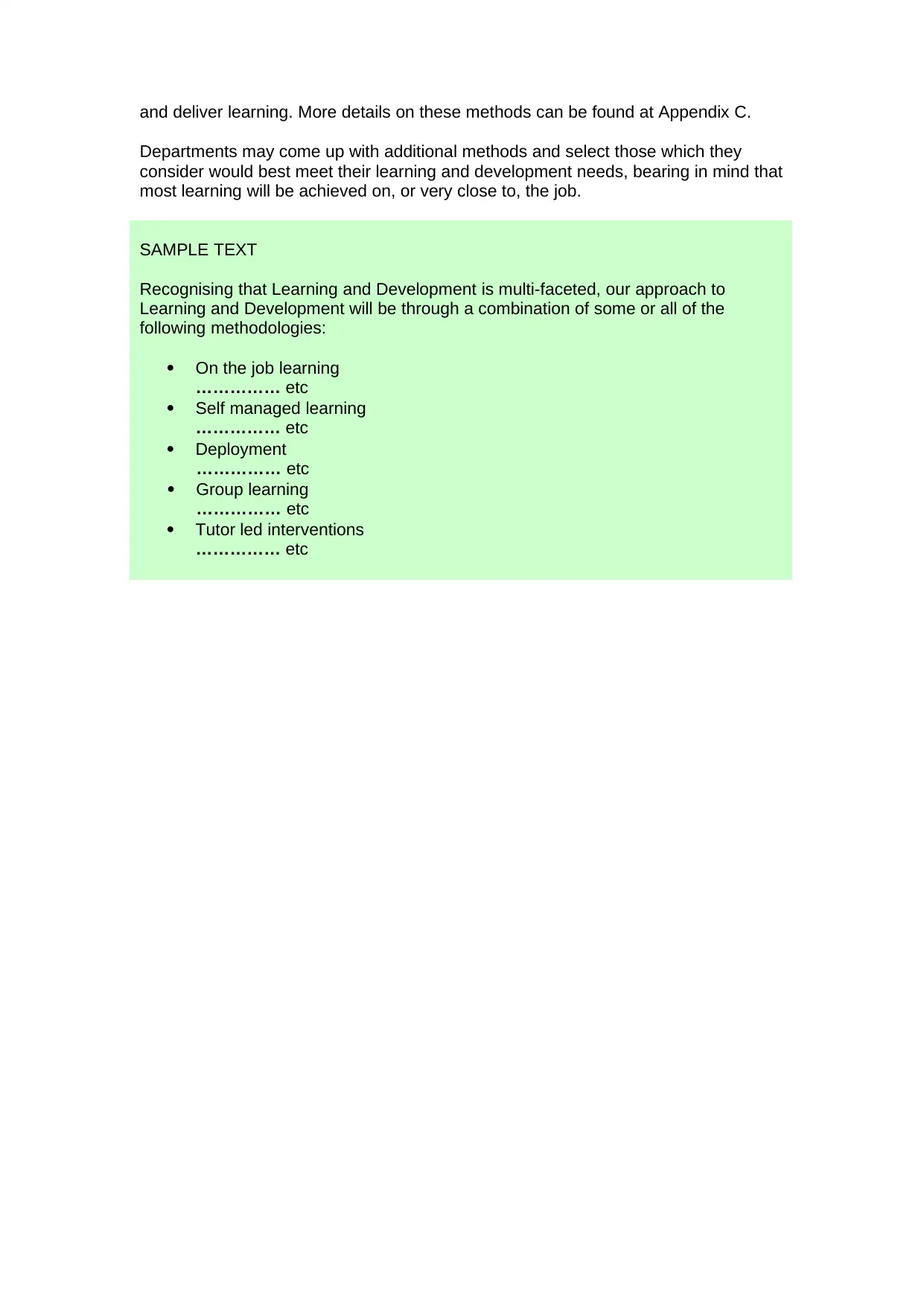
SAMPLE TEXT
Recognising that Learning and Development is multi-faceted, our approach to
Learning and Development will be through a combination of some or all of the
following methodologies:
On the job learning
…………… etc
Self managed learning
…………… etc
Deployment
…………… etc
Group learning
…………… etc
Tutor led interventions
…………… etc
and deliver learning. More details on these methods can be found at Appendix C.
Departments may come up with additional methods and select those which they
consider would best meet their learning and development needs, bearing in mind that
most learning will be achieved on, or very close to, the job.
Recognising that Learning and Development is multi-faceted, our approach to
Learning and Development will be through a combination of some or all of the
following methodologies:
On the job learning
…………… etc
Self managed learning
…………… etc
Deployment
…………… etc
Group learning
…………… etc
Tutor led interventions
…………… etc
and deliver learning. More details on these methods can be found at Appendix C.
Departments may come up with additional methods and select those which they
consider would best meet their learning and development needs, bearing in mind that
most learning will be achieved on, or very close to, the job.
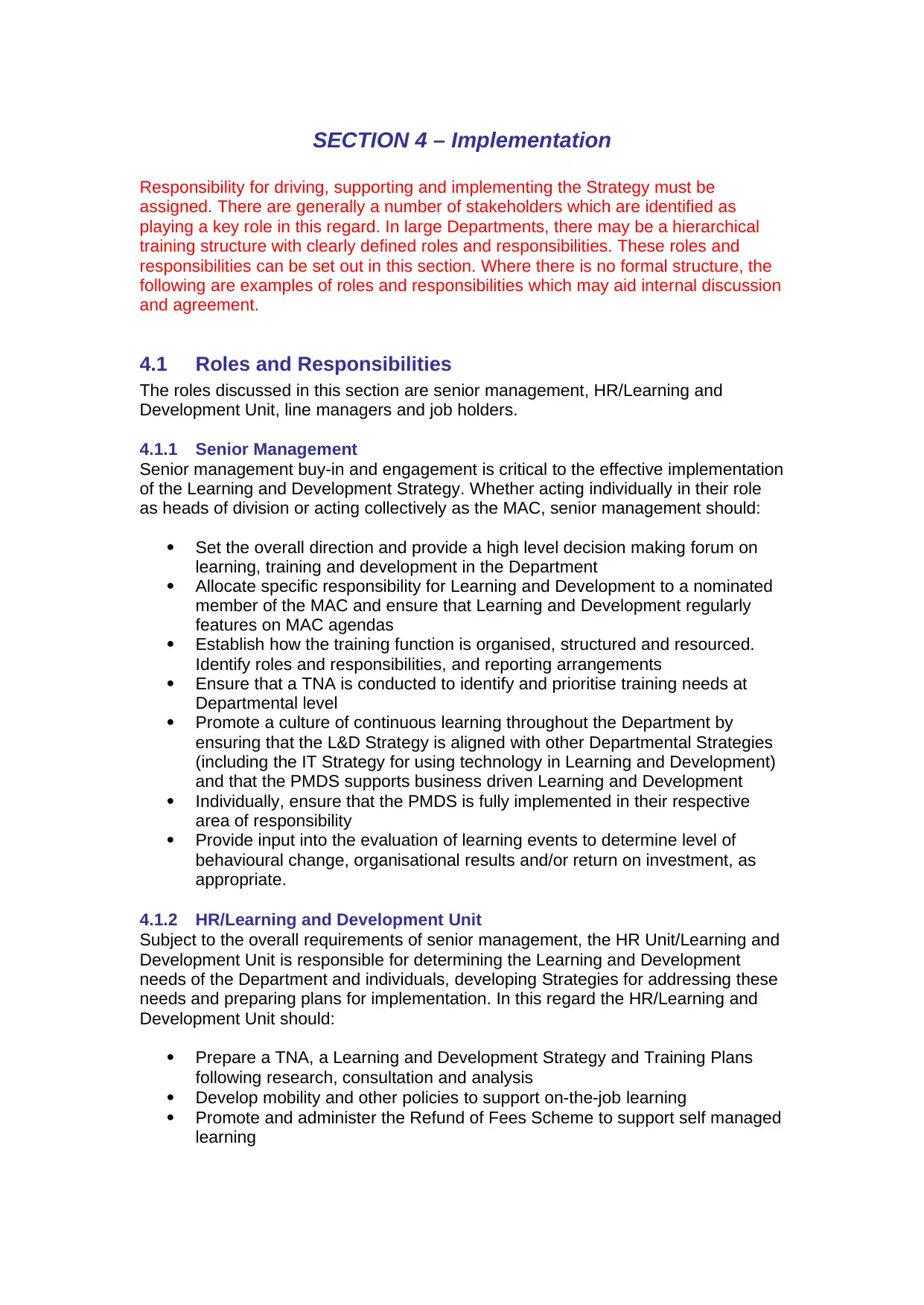
SECTION 4 – Implementation
Responsibility for driving, supporting and implementing the Strategy must be
assigned. There are generally a number of stakeholders which are identified as
playing a key role in this regard. In large Departments, there may be a hierarchical
training structure with clearly defined roles and responsibilities. These roles and
responsibilities can be set out in this section. Where there is no formal structure, the
following are examples of roles and responsibilities which may aid internal discussion
and agreement.
4.1 Roles and Responsibilities
The roles discussed in this section are senior management, HR/Learning and
Development Unit, line managers and job holders.
4.1.1 Senior Management
Senior management buy-in and engagement is critical to the effective implementation
of the Learning and Development Strategy. Whether acting individually in their role
as heads of division or acting collectively as the MAC, senior management should:
Set the overall direction and provide a high level decision making forum on
learning, training and development in the Department
Allocate specific responsibility for Learning and Development to a nominated
member of the MAC and ensure that Learning and Development regularly
features on MAC agendas
Establish how the training function is organised, structured and resourced.
Identify roles and responsibilities, and reporting arrangements
Ensure that a TNA is conducted to identify and prioritise training needs at
Departmental level
Promote a culture of continuous learning throughout the Department by
ensuring that the L&D Strategy is aligned with other Departmental Strategies
(including the IT Strategy for using technology in Learning and Development)
and that the PMDS supports business driven Learning and Development
Individually, ensure that the PMDS is fully implemented in their respective
area of responsibility
Provide input into the evaluation of learning events to determine level of
behavioural change, organisational results and/or return on investment, as
appropriate.
4.1.2 HR/Learning and Development Unit
Subject to the overall requirements of senior management, the HR Unit/Learning and
Development Unit is responsible for determining the Learning and Development
needs of the Department and individuals, developing Strategies for addressing these
needs and preparing plans for implementation. In this regard the HR/Learning and
Development Unit should:
Prepare a TNA, a Learning and Development Strategy and Training Plans
following research, consultation and analysis
Develop mobility and other policies to support on-the-job learning
Promote and administer the Refund of Fees Scheme to support self managed
learning
Responsibility for driving, supporting and implementing the Strategy must be
assigned. There are generally a number of stakeholders which are identified as
playing a key role in this regard. In large Departments, there may be a hierarchical
training structure with clearly defined roles and responsibilities. These roles and
responsibilities can be set out in this section. Where there is no formal structure, the
following are examples of roles and responsibilities which may aid internal discussion
and agreement.
4.1 Roles and Responsibilities
The roles discussed in this section are senior management, HR/Learning and
Development Unit, line managers and job holders.
4.1.1 Senior Management
Senior management buy-in and engagement is critical to the effective implementation
of the Learning and Development Strategy. Whether acting individually in their role
as heads of division or acting collectively as the MAC, senior management should:
Set the overall direction and provide a high level decision making forum on
learning, training and development in the Department
Allocate specific responsibility for Learning and Development to a nominated
member of the MAC and ensure that Learning and Development regularly
features on MAC agendas
Establish how the training function is organised, structured and resourced.
Identify roles and responsibilities, and reporting arrangements
Ensure that a TNA is conducted to identify and prioritise training needs at
Departmental level
Promote a culture of continuous learning throughout the Department by
ensuring that the L&D Strategy is aligned with other Departmental Strategies
(including the IT Strategy for using technology in Learning and Development)
and that the PMDS supports business driven Learning and Development
Individually, ensure that the PMDS is fully implemented in their respective
area of responsibility
Provide input into the evaluation of learning events to determine level of
behavioural change, organisational results and/or return on investment, as
appropriate.
4.1.2 HR/Learning and Development Unit
Subject to the overall requirements of senior management, the HR Unit/Learning and
Development Unit is responsible for determining the Learning and Development
needs of the Department and individuals, developing Strategies for addressing these
needs and preparing plans for implementation. In this regard the HR/Learning and
Development Unit should:
Prepare a TNA, a Learning and Development Strategy and Training Plans
following research, consultation and analysis
Develop mobility and other policies to support on-the-job learning
Promote and administer the Refund of Fees Scheme to support self managed
learning
⊘ This is a preview!⊘
Do you want full access?
Subscribe today to unlock all pages.

Trusted by 1+ million students worldwide
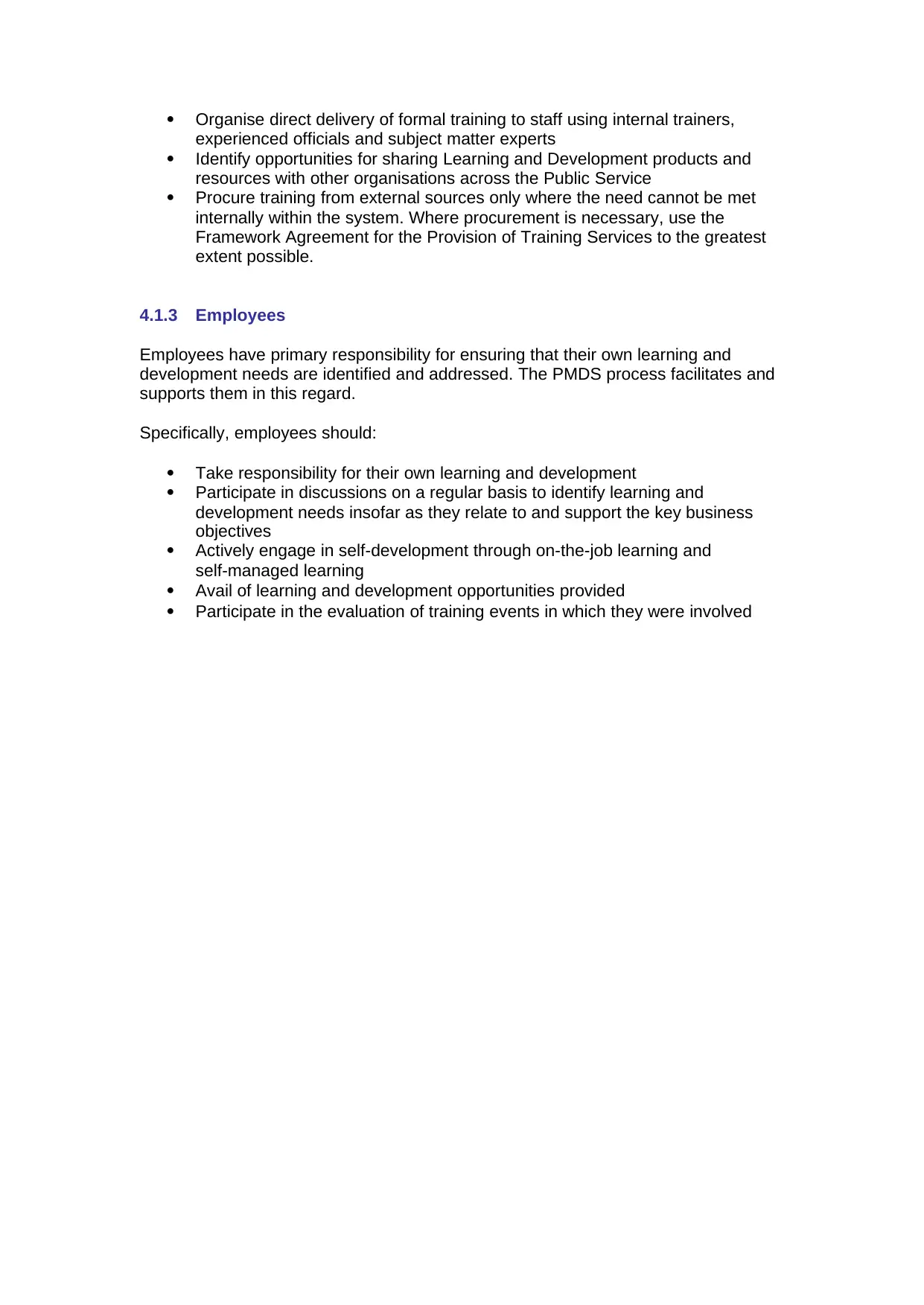
Organise direct delivery of formal training to staff using internal trainers,
experienced officials and subject matter experts
Identify opportunities for sharing Learning and Development products and
resources with other organisations across the Public Service
Procure training from external sources only where the need cannot be met
internally within the system. Where procurement is necessary, use the
Framework Agreement for the Provision of Training Services to the greatest
extent possible.
4.1.3 Employees
Employees have primary responsibility for ensuring that their own learning and
development needs are identified and addressed. The PMDS process facilitates and
supports them in this regard.
Specifically, employees should:
Take responsibility for their own learning and development
Participate in discussions on a regular basis to identify learning and
development needs insofar as they relate to and support the key business
objectives
Actively engage in self-development through on-the-job learning and
self-managed learning
Avail of learning and development opportunities provided
Participate in the evaluation of training events in which they were involved
experienced officials and subject matter experts
Identify opportunities for sharing Learning and Development products and
resources with other organisations across the Public Service
Procure training from external sources only where the need cannot be met
internally within the system. Where procurement is necessary, use the
Framework Agreement for the Provision of Training Services to the greatest
extent possible.
4.1.3 Employees
Employees have primary responsibility for ensuring that their own learning and
development needs are identified and addressed. The PMDS process facilitates and
supports them in this regard.
Specifically, employees should:
Take responsibility for their own learning and development
Participate in discussions on a regular basis to identify learning and
development needs insofar as they relate to and support the key business
objectives
Actively engage in self-development through on-the-job learning and
self-managed learning
Avail of learning and development opportunities provided
Participate in the evaluation of training events in which they were involved
Paraphrase This Document
Need a fresh take? Get an instant paraphrase of this document with our AI Paraphraser

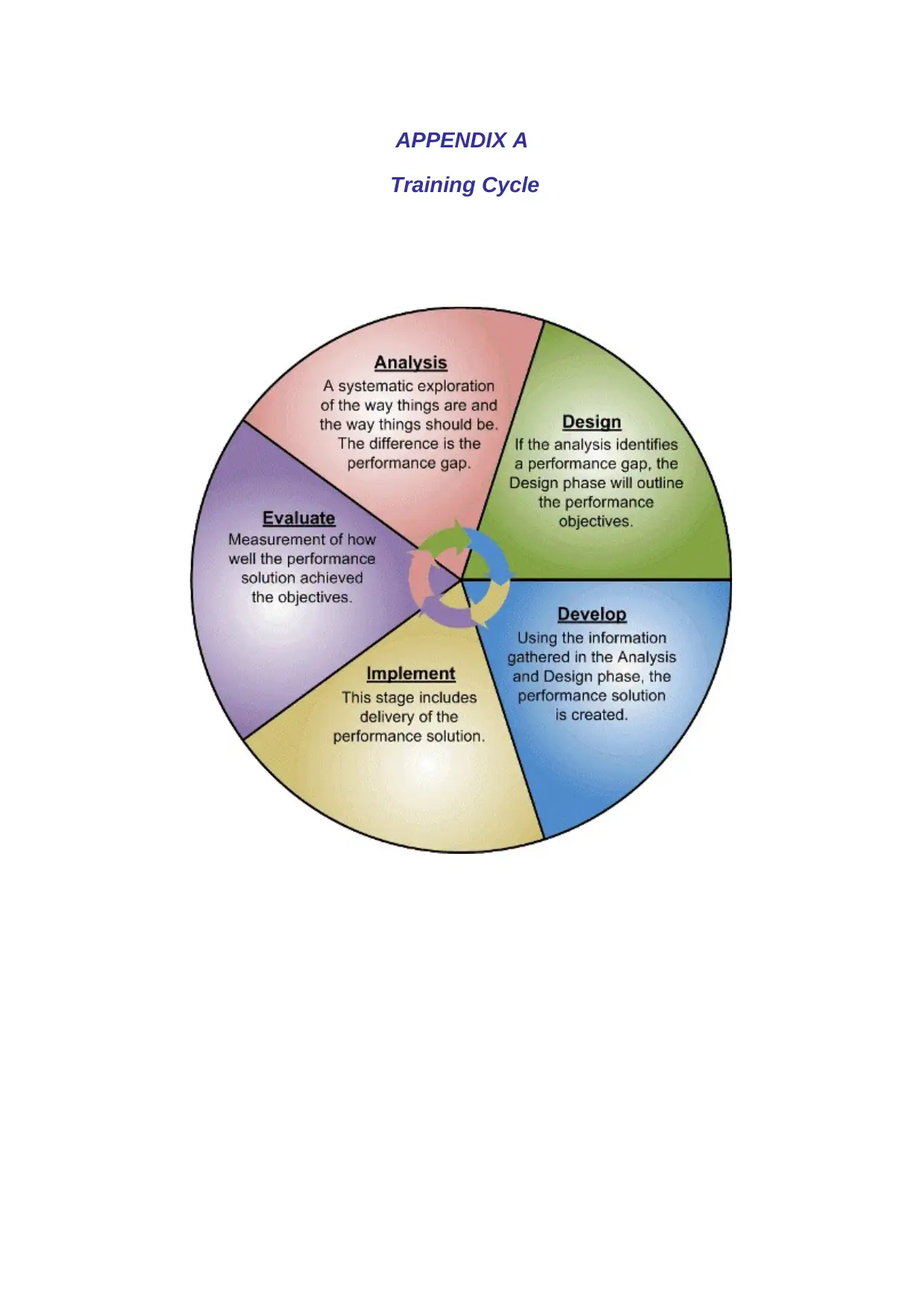
APPENDIX A
Training Cycle
Training Cycle
⊘ This is a preview!⊘
Do you want full access?
Subscribe today to unlock all pages.

Trusted by 1+ million students worldwide
1 out of 18
Related Documents
Your All-in-One AI-Powered Toolkit for Academic Success.
+13062052269
info@desklib.com
Available 24*7 on WhatsApp / Email
![[object Object]](/_next/static/media/star-bottom.7253800d.svg)
Unlock your academic potential
Copyright © 2020–2025 A2Z Services. All Rights Reserved. Developed and managed by ZUCOL.





